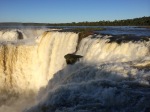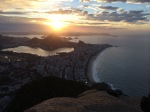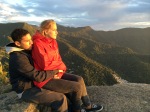Little Known Wonders of Brazil

This is me greeting the sunrise atop Pedra dos Dois Irmaos looking east toward Pao de Azucar. Corcovado to the left. 6am
The inspiration for this trip to Brazil began a number of years ago when I saw a photo of a most extraordinary place: miles and miles of deep white dunes pocked by crystal blue lagoons shining in the tropical sun. Upon investigation I found out this was Lencois Maranhenses, a place this rather well travelled and geographically knowledgeable person had never heard of. It lay on the Atlantic Coast of Brazil about two hundred miles south of the mouth of the Amazon, and I vowed that I would get there one day. It didn’t look easy but I would make it something of a pilgrimage.
Brazil, it seems, has more wonders inside it’s borders than most Americans, at least, know. On this trip I went to Iguazu Falls which lies on the Iguazu River in southwestern Brazil on the border with Argentina and just upstream from Paraguay. I met my friend French friend Constant and his girlfriend Paola and we spent two very full days hiking and boating and standing with our mouths open in amazement. The Itaipu Dam, easily a modern man made wonder is nearby on the Parana River, and until the recent construction of the Three Gorges Dam in China, was the largest man made structure in the world. After Iguazu I went to Rio for five days, a city full of it’s own wonders, to visit my friend Michael from Germany. You are probably more familiar with the beauty of this place, or at least I suspect you will be after the Summer Olympics there in 2016. Finally, I took the pilgrimage trip to Lencois Maranhenses by myself and it was indeed not easy to get to. Two flights to the small coastal town of Sao Luis, a night in a fleabag hotel where I almost killed myself on an untempered glass shower door which shattered at my feet, and then a rockin’ four hour bus trip to the actual park entrance.
I left more wonderful things for a future trip: the Amazon of course, the Pantanal, and the futuristic capital of Brasilia designed from scratch right out of the jungle.
Iguazu Falls – Facts and Figures and OMG
Ranking waterfalls is a subjective affair. Are you looking for the highest? The widest? The greatest flow volume? Maybe something aesthetic about the setting? Here are some fact and figures.
Angel Falls at 3212 ft. is pretty clearly the tallest waterfall in the world, but it’s flow is not great, and sometimes the water does not even make it to the bottom before evaporating. Judged by height Iguazu Falls at 269 ft. is not even in the top 1000 waterfalls in the world.
Since very few rivers have a stable flow volume because rainfall and glacier melt usually vary quite a bit throughout the year, ranking rivers this way is challenging (Niagra Falls, which empties four of the Great Lakes into Lake Ontario is exceptionally stable). Khone Falls on the Mekong River in Laos is by any reasonable measure the widest, however, at 35,376 feet (6.7 miles/10.78 km) during the monsoon season. For comparison, Iguazu is the fifth widest at 8,800 ft. (1.67 miles/2.68 kms), Victoria Falls on the Zambezi River is eleventh widest at 5,600 ft. (1.06 miles/1.7 kms) and Niagra Falls is thirteenth widest at 3,950 feet (.75 miles/1.2 kms).
Ranking waterfalls by volume is especially subjective. Besides varying because of climatic conditions, many large flow waterfalls have been harnessed for hydroelectric purposes. Then there is the question of whether to include rivers like the Inga waterfall on the Congo River which is really a series of cascades over a nine mile stretch. Nevertheless, Iguazu Falls clearly lies in the top ten just behind Niagra Falls. When I was there I was lucky enough to see the falls at a rather high level after recent rains.
Then, of course, there is the setting, the most subjective measure possible. According to the folks at World Waterfall Database (worldwaterfalldatabase.com) this is where Iguazu Falls sails to the top. To quote them: “This is what Niagara Falls should have been – pristine, protected and allowed to flow unabated with the full wrath of its river. This is nature at its most primal, most incredible and most spectacular. There was no question in our minds, Iguazú Falls is the best waterfall on the planet and there’s really nothing else that needs to be said.” The Iguazu River flows right out of the jungle over cliffs that twist and turn for one and two thirds miles, speckled with trees and rocks and small islands. The mists is so great that when the sun is shining there are rainbows all around. I hope my photos do it justice!
Rio De Janeiro

The basic layout of Rio de Janeiro. Corcovado is the mountain in the center with the Christ statue. Pao de Azucar with it’s cable cars is to the right (east) abutting Guanabara Bay. The twin mountains (Dos Irmaos) where I watched the sunrise is to the left (west) above Leblon.
You may be surprised to find out that the Harbor of Rio De Janeiro, on Guanabara Bay, has been deemed to be one of the seven natural wonders of the world [along with the Aurora Borealis, the Grand Canyon, the Great Barrier Reef, Mount Everest, Paricutin (a Mexican volcano), and Victoria Falls (Iguazu robbed!)]. This was determined by an organization called, what else?, Seven Natural Wonders. Just who that organization is you can read about by clicking here.
This really isn’t a stretch, because Rio de Janeiro lies in what has to be the most singularly gorgeous and unusual physical setting of any city in the world. Guanabara Bay is transversed by the Serra do Mar mountain range which runs at varying elevations for 1500 miles along the east coast of South America. Giant pillars of granite poke up through the ground to great heights around the city from where one can see some of the world’s great beaches and most colorful slums. It’s an atonishing sight. I managed to get to the top of three of them.
The largest of these granite pillars (within the city) is called Corcovado at 2300 feet (700 m) above the horizon. One can take a taxi here up through the Santa Marta favela (slum) where Michael Jackson filmed his music video “They Don’t Care About Us”. At the top is the statue of Christ the Redeemer (Christo Redentor) which is packed with tourists on days when it’s not enshrouded in fog. If you have a picture of Rio de Janeiro in your head, it is probably an image of this statue of Christ looking down on Rio. It is indeed an impressive statue with an impressive view, even more so I’m sure if you happen to be Christian. For these reasons alone, going to Corcovado is somewhat obligatory for the tourist.
The second most common pillar scaled by tourists is Pao de Azucar (SugarLoaf), mostly accessible by cable car. I braved the crowds on a beautiful evening to get pictures of the city at sunset. Highly recommended! Really a breathtaking sight, just try not to imagine the hundreds of people just outside the camera frame.
A far less touristy thing to do, apparently, is to watch the sunRISE from the pillars of Dos Irmaos. For this, I got up in the middle of the night to meet my friend Michael and his girlfriend Sarah at their apartment at 4am. We hailed a taxi to the Vidigal favela where we wound our way up to where a very non official trail began, accessible between two nondescript houses. We used our iPhones as flashlights in the dark for the hour climb and when we got to the top we found ourselves alone at the top, the lights of Rio at our feet just before the sun came up. It was almost humbling to be alone here and a bit mind boggling that no one else in this city of millions thought to come up here this night to witness this beautiful scene. I’m really grateful to Michael and Sarah for suggesting this unorthodox hike.
Wherever one goes in Rio, the favelas are all around. These poor neighborhoods where most of the labor force of Rio lives were until recently mostly governed by local “authorities” outside of the official city government. The word favela is sometimes translated as “slum” into English, but this is a bit inaccurate as these neighborhoods do not have the squalor or hopelessness of a “slum” in the shadow of an American city, for example. Granted, they are poor, but they are also colorful bastions of resourcefulness and neighborliness. For the most part I felt safe there. I would definitely recommend going on a tour of a favela when you are in Rio. I thought it might be unseemly for a “wealthy American” to be touring other’s “misfortune,” but this turned out to be a misconception. For good reason, the people there had no reason to be ashamed and they were not. Part of our tour fee when to help out a school there.
Lencois Maranhenses
So, getting to Lencois Maranhenses did turn out to be something of a pilgrimage. I set out by myself from Rio, and two flights later I landed in the small coastal town of Sao Luis, about 200 miles south of the Amazon. For me, this place was a way station where I planned to sleep for the night before I set out on a four hour bus trip to the park entrance the next day. What I had expected would be an uneventful overnight, however, became more exciting when I turned off the water in the shower of my one star motel, and the glass door shattered into a million pieces around me, three shards of which found their way into my wrist and thumb. Time to think fast! Luckily I did not injure my feet or my entire trip to Lencois Maranhenses, my motivation for going to Brazil in the first place, would have been for nought. Thank God for copious amounts of iodine. I was not deterred!
Lancois Maranhenses did not disappoint my expectations. Surely, the only reason most people have not heard of this place is because it is rather difficult to get to and not near many other sites for tourists. Not since Iceland have I fell so much like I was walking across the surface of some alien planet. The park is comprised of 580 square miles of rolling sand dunes composed of the most beautiful white sand. Although it looks like a desert to most people’s eyes, it actually receives up to 75 inches of torrential rain during the wet season from January to May. This water does not drain down due to an impenetrable layer of bedrock, and instead fills up the depressions between the dune peaks with spectacular lagoons. One needs a guide to visit this protected area, but it is possible to swim in the lagoons and most people I saw there did (not those worried about keeping bacteria out of wounds on their hands). For the nature photographer, this place is a dream. For a more complete understanding of the physics of how these dunes form and change, a great resource is here.
Getting home from this remote place while nursing an injury required what I think of as a travel meditation mindset. You can’t think too much of how much you have to do, or when you’ll sleep, or how much farther or longer you have to go. Just stay in the moment appreciating the beauty around you and your task at hand. Soon enough you are back in your own bed.
Just click on the photos to make them larger.
- This photo of Iguazu Falls has to be the most kinetic picture I’ve ever taken. It’s surreal but not photoshopped. There was another fall to my left which was the source of the rapids in the foreground. Because of the mist it is almost impossible to take a photo at Iguazu Falls on a sunny day without a rainbow.
- This was my first close up glimpse of the falls on the Argentinian side on the first day. All of Iguazu Falls is nearly 3000 ft. long, so this is just a small portion.
- View from the top on the Argentinian side. The water was murky and flowing fully from recent rains.
- Getting ready to be soaked.
- This is the perfect place to utilize “pano” capability. Garganta del Diablo (Devil’s Throat); Argentine side.
- Garganta Del Diablo
- My friends Constant and Paola
- Iguazu Falls from the Brazilian side.
- Rio de Janeiro; from a taxi on my way to Christo Redentor on top of Corcovado
- The obligatory Christ the Redeemer photo. When not enshouded in clouds this site is packed with tourists.
- The view toward Ipanema from the top of Corcovado
- Pano shot of Copacabana beach.
- View of Copacabana beach from Forte Copacabana
- I heard that the sunset from the top of Pao de Azucar was spectacular. Here I’m going up the second cable car to the top.
- Sunset from Pao de Azucar I
- Sunset from Pao de Azucar II Note the moon and the lit Christ the Redeemer statue.
- Sunset from Pao de Azucar III
- Favela Rocinha Note the houses topped with blue cisterns and white satellite dishes.
- Street scene in the favela.
- Surfers at Ipanema beach
- This is me greeting the sunrise atop Pedra dos Dois Irmaos looking east toward Pao de Azucar. Corcovado to the left. 6am
- My German friend Michael and his girlfriend Sarah.
- The last stop on my trip…I made it to Parque Lencois Maranhenses after many hours of traveling and one frightening injury (note bandaged thumb).
- Where the jungle meets the sand. Note a gradual transition!
- My attempt at taking the cleanest photo possible just after sunset. The moon hangs above.
- Thank you for checking out my photos of the wonders of Brazil. I know there are more which I’ll save for a future trip.
Posted on August 2, 2015, in Uncategorized. Bookmark the permalink. 4 Comments.





































The photos are gorgeous. I especially love the Sunrise with you spreading your arms out to embrace it, just like you embrace life. So many others I could count as favorites. Among them : you, back to camera looking out at the dunes and the basin of water, Garganta Del Diablo cascading down, the ” KENETIC” shot of Iguazu Falls, and the last in the series of the sunset. The ferocity of those falls combined with their beauty is magical.
You still amaze me time and again at your ability to take life in stride, no big deal to have your hand cut up , still going to venture on, and your enthusiasm, joy, and openness to whatever adventure is offered you.
Thank you. Great blog.
Those are some white dunes indeed! Love that crazy alien planet view! Hmm. Maybe I should go? 🙂
Hi Craig…How delightful to see you enjoying your special trips. Those sand dune shots were amazing! Thanks for sharing. We have a friend visiting with us from Pinehurst at the moment so can’t spend much more time on email. Love & Hugs, Beth & Ralph
Well done.